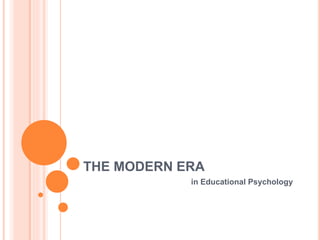
THE MODERN ERA of E.P. part1.pptx
- 1. THE MODERN ERA in Educational Psychology
- 2. CONTEMPORARY VIEWS OF LEARNING AND MOTIVATION Educational psychologists have studied cognition, instruction, learning, motivation, individual differences, and the measurement of human abilities, to name just a few areas that relate to education and schooling. Of all these, perhaps the study of learning is the most closely associated with education. Different theories of learning have had different impacts on education and have supported different practices.
- 3. BEHAVIORAL VIEWS OF LEARNING The behavioral approach to learning developed out of work by Skinner, whose research in operant conditioning showed that voluntary behavior can be altered by changes in the antecedents of the behavior, the consequences, or both. Early work focused on consequences and demonstrated that consequences following an action may serve as reinforcement or punishment. Skinner's theories have been used extensively in education, by applying principles of reinforcement and punishment to change behaviors, often called applied behavior analysis.
- 4. For much of the 1960s Skinner's ideas and those of behaviorists who followed him shaped teaching in regular and special education, training in the military, coaching, and many other aspects of education. Principles of reinforcement continue to be important for all teachers, particularly in classroom management and in decisions about grades and incentives for learning. In the 1970s and 1980s a number of educational psychologists turned their attention from research on learning to research on teaching. Their findings shaped educational policy and practice during those years and since. Much of the research that focused on effective teaching during that time period pointed toward a model of teaching that is related to improved student learning called direct instruction or explicit teaching.
- 5. COGNITIVE VIEWS OF LEARNING Behaviorists define learning as a change in behavior brought about by experience with little concern for the mental or internal aspects of learning. Cognitive psychologists, on the other hand, focus on individual and developmental differences in cognition; they have not sought general laws of learning. Cognitive views of learning are consistent with the educational theories of Bruner and Ausubel and with approaches that teach learning strategies, such as summarizing, organizing, planning, and note taking.
- 6. CONSTRUCTIVIST THEORIES OF LEARNING Constructivist perspectives on learning and teaching are increasingly influential today. These views are grounded in the research of Piaget, Lev Vygotsky, the Gestalt psychologists, Fredric Bartlett, and Bruner as well as the Progressive educational philosophy of Dewey. There are constructivist approaches in science and mathematics education, in educational psychology and anthropology, and in computer-based education. Some constructivist views emphasize the shared, social construction of knowledge; others see social forces as less important.
- 7. Even though there is no single constructivist theory, many constructivist teaching approaches recommend the following: Complex, challenging learning environments and authentic tasks Social negotiation and shared responsibility as a part of learning Multiple representations of content Understanding that knowledge is constructed Student-centered instruction
- 8. Inquiry is an example of constructivist teaching. Dewey described the basic inquiry learning format in 1910. There have been many adaptations of this strategy, but the teacher usually presents a puzzling event, question, or problem. The students formulate hypotheses to explain the event or solve the problem, collect data to test the hypotheses, draw conclusions, and reflect on the original problem and on the thinking processes needed to solve it. Like discovery learning, inquiry methods require great preparation, organization, and monitoring to be sure everyone is engaged and challenged.
- 9. A second example of constructivist teaching influenced by Vygotsky's theories of assisted learning is called cognitive apprenticeships. There are many models, but most share six features: Students observe an expert (usually the teacher) model the performance. Students get external support through coaching or tutoring (including hints, feedback, models, reminders). Conceptual scaffolding (in the form of outlines, explanations, notes, definitions, formulas, procedures, etc.) is provided and then gradually faded as the student becomes more competent and proficient. Students continually articulate their knowledge–putting into words their understanding of the processes and content being learned. Students reflect on their progress, comparing their problem solving to an expert's performance and to their own earlier performances. Students are required to explore new ways to apply what they are learning–ways that they have not practiced at the professional's side.
- 11. Behaviorists explain motivation with concepts such as "reward" and "incentive." Rewards are desirable consequences for appropriate behavior; incentives provide the prospect for future rewards. Giving grades, stars, and so on for learning–or demerits for misbehavior–is an attempt to motivate students by extrinsic (external) means of incentives, rewards, and punishments. Humanistic views of motivation emphasize such intrinsic (internal) forces as a person's needs for "self-actualization," the inborn "actualizing tendency," or the need for "self- determination." From the humanistic perspective, motivation of students means to encourage their inner resources– their sense of competence, self-esteem, autonomy, and self-actualization.